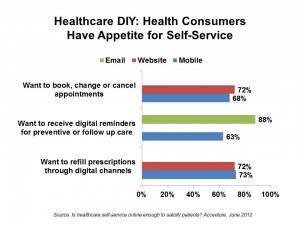 The supply-side of healthcare DIY is growing, with the advancement of Castlight Health through its $100mm VC influx and Cakehealth’s new version for managing health spending online. Consumer demand is growing, too, for these services.
The supply-side of healthcare DIY is growing, with the advancement of Castlight Health through its $100mm VC influx and Cakehealth’s new version for managing health spending online. Consumer demand is growing, too, for these services.
But don’t get over-hyped by the healthcare, everywhere, scenario. Health citizens also demand face-to-face time with their physicians and clinicians, evidenced by a survey from Accenture titled, Is healthcare self-service online enough to satisfy patients?
The answer is a clear, “no.”
90% of U.S. adults like the idea of digital health self-service, 83% want online access to personal health information, 72% want to book appointments online, as well as do e-Prescribing. Email and mobile are also important channels for self-service healthcare, as shown in the graph.
Health Populi’s Hot Points: Consider how people project-manage their reading these days. While many consumers enjoy their Kindle and Nook e-readers, they’ll still delight in going into a bricks-and-mortar Barnes & Noble or, if they’re lucky enough to have an independent bookseller in their community, one of those dying breeds of mom-and-pop shops. It’s still wonderful to hold a book-book, to sample some pages, before buying an e-book from the cloud.
Health consumers do second opinions via online, via Google and expert blogs from physicians and patient-people-like-me, and on social networks crowdsourcing health data at CureTogether, PatientsLikeMe, and WEGOHealth, among other citizen-health sites. But patients live in a health ecosystem with physicians and pharmacies, worksite clinics and retail clinics, school-based health and White Glove house calls. Health care is project-managed each day on a variety of platforms via many channels, some “live” in an office, some via videoconference, and still others via mobile.
Face-time with physicians and care providers is still highly valued by patients. Increasingly, doctors, as they grow their embrace of value-based health plans and being paid by performance and outcomes, and not for volume of patients seen in the office, will be educating patients about their options for healthcare, any- and every-where.




 Interviewed live on BNN Bloomberg (Canada) on the market for GLP-1 drugs for weight loss and their impact on both the health care system and consumer goods and services -- notably, food, nutrition, retail health, gyms, and other sectors.
Interviewed live on BNN Bloomberg (Canada) on the market for GLP-1 drugs for weight loss and their impact on both the health care system and consumer goods and services -- notably, food, nutrition, retail health, gyms, and other sectors. Thank you, Feedspot, for
Thank you, Feedspot, for  As you may know, I have been splitting work- and living-time between the U.S. and the E.U., most recently living in and working from Brussels. In the month of September 2024, I'll be splitting time between London and other parts of the U.K., and Italy where I'll be working with clients on consumer health, self-care and home care focused on food-as-medicine, digital health, business and scenario planning for the future...
As you may know, I have been splitting work- and living-time between the U.S. and the E.U., most recently living in and working from Brussels. In the month of September 2024, I'll be splitting time between London and other parts of the U.K., and Italy where I'll be working with clients on consumer health, self-care and home care focused on food-as-medicine, digital health, business and scenario planning for the future...